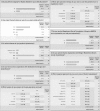Thymectomy for thymoma and myasthenia gravis. A survey of current surgical practice in thymic disease amongst EACTS members
- PMID: 22374292
- PMCID: PMC3352719
- DOI: 10.1093/icvts/ivs046
Thymectomy for thymoma and myasthenia gravis. A survey of current surgical practice in thymic disease amongst EACTS members
Abstract
Thymic disorders, both oncological and non-oncological, are rare. Multi-institutional, randomized studies are currently not available. The Thymic Working Group of the European Association for Cardio-Thoracic Surgery (EACTS) decided to perform a survey aiming to estimate the extent and type of current surgical practice in thymic diseases. A questionnaire was addressed to the thoracic and cardio-thoracic members of the society, and the answers received from 114 participants were analysed. High-volume surgeons cooperate more frequently with a dedicated neurologist and anaesthesist (P = 0.04), determine more frequently neurological scores pre- and postoperatively (P = 0.02) and do not operate on thymic hyperplasia in stage I myasthenia gravis (MG) (P = 0.04). High-volume thymoma surgeons more often use a transpleural approach for stage I thymoma < 4 cm (P = 0.01), induction therapy (P = 0.05) and are more likely to have access to a tissue bank (P = 0.04). Both in thymoma and MG surgery, cooperative prospective studies seem to be feasible in dedicated thoracic surgical associations as EACTS.
Figures



Similar articles
-
Myasthenia Gravis and Thymoma Surgery: A Clinical Update for the Cardiothoracic Anesthesiologist.J Cardiothorac Vasc Anesth. 2019 Sep;33(9):2537-2545. doi: 10.1053/j.jvca.2018.07.036. Epub 2018 Jul 29. J Cardiothorac Vasc Anesth. 2019. PMID: 30219643 Review.
-
"Maximal" thymectomy for myasthenia gravis. Surgical anatomy and operative technique.J Thorac Cardiovasc Surg. 1988 Nov;96(5):711-6. J Thorac Cardiovasc Surg. 1988. PMID: 3184965
-
Different neurologic outcomes of myasthenia gravis with thymic hyperplasia and thymoma after extended thymectomy: A single center experience.J Neurol Sci. 2017 Dec 15;383:93-98. doi: 10.1016/j.jns.2017.10.026. Epub 2017 Oct 18. J Neurol Sci. 2017. PMID: 29246632
-
Thymomectomy plus total thymectomy versus simple thymomectomy for early-stage thymoma without myasthenia gravis: a European Society of Thoracic Surgeons Thymic Working Group Study.Eur J Cardiothorac Surg. 2021 Oct 22;60(4):881-887. doi: 10.1093/ejcts/ezab224. Eur J Cardiothorac Surg. 2021. PMID: 34023891 Free PMC article.
-
Robotic thymectomy for myasthenia gravis.Thorac Surg Clin. 2014 May;24(2):189-95, vi-vii. doi: 10.1016/j.thorsurg.2014.02.012. Thorac Surg Clin. 2014. PMID: 24780423 Review.
Cited by
-
Management of large mediastinal masses: surgical and anesthesiological considerations.J Thorac Dis. 2016 Mar;8(3):E175-84. doi: 10.21037/jtd.2016.02.55. J Thorac Dis. 2016. PMID: 27076967 Free PMC article. Review.
References
-
- Phillips LH., 2nd The epidemiology of myasthenia gravis. Ann N Y Acad Sci. 2003;998:407–12. - PubMed
-
- Masaoka A, Yamakawa Y, Niwa H, Fukai I, Kondo S, Kobayashi M, et al. Extended thymectomy for myasthenia gravis patients: a 20-year review. Ann Thorac Surg. 1996;62:853–9. - PubMed
-
- Jaretzki A, 3rd, Barohn RJ, Ernstoff RM, Kaminski HJ, Keesey JC, Penn AS, et al. Myasthenia gravis: recommendations for clinical research standards. Task Force of the Medical Scientific Advisory Board of the Myasthenia Gravis Foundation of America. Ann Thorac Surg. 2000;70:327–34. - PubMed
-
- Detterbeck F, Giaccone G, Loehrer P, Suster S, Wright C. International thymic malignancy interest group. J Thorac Oncol. 2010;5:1–2. - PubMed
-
- Detterbeck F. International thymic malignancies interest group: a way forward. J Thorac Oncol. 2010;5:S365–70. - PubMed
MeSH terms
LinkOut - more resources
Full Text Sources
Medical

